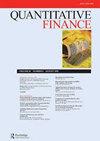Rule-based trading on an order-driven exchange: a reassessment
IF 1.4
4区 经济学
Q3 BUSINESS, FINANCE
引用次数: 0
Abstract
AbstractA core research area of computational behavioral finance investigates emergent price dynamics when heterogeneous traders follow a mix of rule-based strategies and interact indirectly through a limit order book. This paper offers a detailed specification of such a model in order to raise questions about some previous findings. The questions force a comprehensive reconsideration of the price dynamics of a well-known model. This leads to a surprising clarification of the contributions of various trading strategies to market outcomes: a popular characterization of chartism proves largely irrelevant for price dynamics. We also shed new light on the volume-volatility relationship, and provide improved visualizations to expose market behavior.Keywords: ChartismPrice dynamicsReturn volatilityTrade volumeMarket microstructureLimit order bookComputational behavioral financeJEL Classifications: G12G17C63 Open ScholarshipThis article has earned the Center for Open Science badges for Open Data and Open Materials through Open Practices Disclosure. The data and materials are openly accessible at https://figshare.com/s/e02cbb7790ab902eb72e.AcknowledgmentsEqual authorship; the authors are in alphabetical order. We thank Ben Dempe, two anonymous referees, and an Associate Editor for helpful suggestions. We particularly thank Blake LeBaron for useful discussions and kind encouragement.Disclosure statementNo potential conflict of interest was reported by the author(s).Supplemental dataSupplemental data for this article can be accessed online at http://dx.doi.org/10.1080/14697688.2023.2270711.Notes1 If all floating point prices were acceptable, the market would not see common prices across orders. However, a market in a security typically has a tick size, which is the minimal price increment. In addition, order prices outside an acceptable (wide) trading range are typically rejected. Chiarella and Iori (Citation2002, p. 348) address this by introducing a pre-specified grid of possible prices, based on the tick size (Δ). (Unfortunately, they do not document the minimum and maximum values of this grid.) We follow this practice, specifying a (wide) range of possible prices, from 1% to 200% of the reference fundamental price.2 In order to produce the plausible price dynamics required of a replication, their reported parameterization must be substantially rescaled during the price-forecast computation, as exposed by Chiarella et al. (Citation2009) and especially Pellizzari and Westerhoff (Citation2009). In addition, Chiarella et al. (Citation2009) constrain the weights to be positive, thereby removing contrarians from the chartist traders. The consequences of such a change are discussed in the supplement to our paper.3 This paper uses the fundamental price to initialize the price history. Results with a random initial price history are similar, so the model appears robust to this choice.4 The original code is unavailable (G. Iori, personal communication, 2020). Find code for the present paper at https://figshare.com/s/e02cbb7790ab902eb72e.5 Our supplement to this paper provides detailed documentation of this claim.6 We base this choice on Chiarella and Iori (Citation2002, p. 351–352), which describes the average spot volatility as being in the neighborhood of 2×10−4. This appears to be roughly the value of volatility indicated at around λ=0.5 in Chiarella and Iori (Citation2002, figure 3). However, there are two other imaginable measures for a simulation of N periods of T time steps per period. One is a simple average of CI's time-period volatilities, as described by (Equation6(6) σT=1T∑t=1T|pt−pt−1pt−1|T(6) ). That produces 1N∑n=1N(1T∑i=1T|p(n−1)∗T+ip(n−1)∗T+i−1−1|)=1NT∑n=1N∑i=1T|p(n−1)∗T+ip(n−1)∗T+i−1−1| The other is to apply (Equation6(6) σT=1T∑t=1T|pt−pt−1pt−1|T(6) ) directly to the entire price trajectory. 1NT∑t=1NT|ptpt−1−1|=1NT∑n=1N∑i=1T|p(n−1)∗T+ip(n−1)∗T+i−1−1| Clearly the only difference between these measures is scaling, so the choice between them is arbitrary and inconsequential.7 This means that the first, fifth, and fourth subfigures correspond to the left column of Chiarella and Iori (Citation2002, figure 1).8 More precisely, aside from artefacts of the series construction, the logarithm of the market price should resemble a random walk in this case.9 For this reason, altering the weighting schema to emphasize chartism fails, even when imposing an unreasonably large relative weight on chartism. The supplement to this paper provides additional exploration of these issues.10 Attentive readers will note the scale change in the last subfigure of Chiarella and Iori (Citation2002, figure 1). See the supplement to this paper for further explorations.11 The returns are calculated from the closing prices of Apple Inc. stock (ticker: AAPL) over the 1001 trading days between May 4th, 2016 to April 24, 2020. (Last accessed 2023-10-04.)12 We use a lag length of 10 periods for both tests. However, we also deployed the test using the optimal lag selection methodology prescribed in Escanciano and Lobato (Citation2009). The optimal lag for the Ljung-Box test for the simulated returns was 1, and for AAPL stock was 30. The optimal lag for the McLeod-Li test for the simulated returns was 6, and for AAPL stock was 29. The results were qualitatively the same in all cases as those reported in table 2.13 Box plots are for trade counts seen in at least 10 periods.14 Figure 5 describes the price series, which uses the book's midpoint price if no new trade executes. More market participation makes it more likely that a new bid or ask will beat the top of the book, which increases measured volatility.在订单驱动的交易所中基于规则的交易:重新评估
计算行为金融学的一个核心研究领域是研究异质交易者遵循基于规则的策略组合并通过限价订单间接交互时的紧急价格动态。本文提供了这样一个模型的详细说明,以便对以前的一些发现提出问题。这些问题迫使人们对一个知名模型的价格动态进行全面的重新考虑。这导致了对各种交易策略对市场结果的贡献的一个令人惊讶的澄清:一个流行的图表特征被证明与价格动态基本无关。我们还揭示了交易量与波动性之间的新关系,并提供了改进的可视化显示市场行为。关键词:图表价格动态收益波动交易量市场微观结构限价单计算行为金融学分类:G12G17C63开放奖学金本文通过开放实践披露获得开放数据和开放材料中心徽章数据和材料可在https://figshare.com/s/e02cbb7790ab902eb72e.AcknowledgmentsEqual上公开获取;作者是按字母顺序排列的。我们感谢两位匿名审稿人Ben Dempe和一位副编辑提供的有益建议。我们特别感谢布莱克·勒巴伦的有益讨论和善意鼓励。披露声明作者未报告潜在的利益冲突。补充数据本文的补充数据可以在http://dx.doi.org/10.1080/14697688.2023.2270711.Notes1上在线访问。如果所有的浮点价格都是可接受的,那么市场就不会看到订单之间的共同价格。然而,证券市场通常有一个刻度大小,这是最小的价格增量。此外,超出可接受(宽)交易范围的订单价格通常会被拒绝。Chiarella和Iori (Citation2002,第348页)通过引入基于刻度大小的预先指定的可能价格网格(Δ)来解决这个问题。(不幸的是,他们没有记录这个网格的最小值和最大值。)我们遵循这一做法,指定一个(广泛的)可能的价格范围,从参考基本价格的1%到200%正如Chiarella等人(Citation2009),尤其是Pellizzari和Westerhoff (Citation2009)所揭示的那样,为了产生复制所需的合理的价格动态,他们报告的参数化必须在价格预测计算期间大幅重新调整。此外,Chiarella等人(Citation2009)将权重限制为正,从而从图表交易者中剔除了反向交易者。这种变化的后果在我们论文的补编中进行了讨论本文使用基本价格来初始化价格历史。具有随机初始价格历史的结果是相似的,因此该模型对这种选择似乎是健壮的原始代码不可用(G. Iori, personal communication, 2020)。在https://figshare.com/s/e02cbb7790ab902eb72e.5上找到本文的代码。我们对本文的补充提供了此声明的详细文档我们基于Chiarella和Iori (Citation2002, p. 351-352)的选择,其中描述了平均现货波动率在2×10−4附近。这似乎大致是Chiarella和Iori在λ=0.5左右表示的波动值(Citation2002,图3)。然而,还有另外两种可以想象的方法来模拟每个周期T个时间步长的N个周期。一个是CI的时间段波动率的简单平均值,如(公式6(6)σT=1T∑t=1T|pt−pt−1pt−1| t(6))所示。产生1N∑n=1N(1T∑i=1T|p(n−1)∗T+ip(n−1)∗T+i−1−1|)=1NT∑n=1N∑i=1T|p(n−1)∗T+ip(n−1)∗T+i−1−1|另一种是将(Equation6(6) σT=1T∑T=1T |pt−pt−1pt−1|T(6))直接应用于整个价格轨迹。1NT∑t=1NT|ptpt−1−1|=1NT∑n=1N∑i=1T|p(n−1)∗t +ip(n−1)∗t +i−1−1|显然,这些度量之间的唯一区别是缩放,因此它们之间的选择是任意的和无关紧要的这意味着第一、第五和第四个子图对应于Chiarella和Iori的左列(Citation2002,图1)8更准确地说,除了系列结构的人工制品之外,市场价格的对数在这种情况下应该类似于随机游走由于这个原因,改变权重模式来强调图表是失败的,即使在图表上施加了不合理的相对权重。本文的补编对这些问题作了进一步的探讨细心的读者会注意到Chiarella和Iori的最后一个子图中的尺度变化(Citation2002,图1)。进一步的探索请参见本文的补充部分回报是根据苹果公司股票(股票代码:AAPL)在2016年5月4日至2020年4月24日1001个交易日内的收盘价计算得出的。(最后访问日期:2023-10-04)12我们对两个测试使用了10个周期的延迟长度。 然而,我们也使用Escanciano和Lobato (Citation2009)规定的最优滞后选择方法进行了测试。Ljung-Box测试对模拟收益的最佳滞后为1,对苹果股票的最佳滞后为30。麦克劳德-李检验对模拟收益的最佳滞后为6,对苹果股票的最佳滞后为29。所有病例的结果与表2.13中报告的结果在质量上是相同的。箱形图显示了至少10个时期的贸易计数图5描述了价格序列,如果没有新的交易执行,它使用账簿的中点价格。更多的市场参与使得新的买入价或买入价更有可能超过账面顶部,这增加了衡量波动性。
本文章由计算机程序翻译,如有差异,请以英文原文为准。
求助全文
约1分钟内获得全文
求助全文
来源期刊

Quantitative Finance
社会科学-数学跨学科应用
CiteScore
3.20
自引率
7.70%
发文量
102
审稿时长
4-8 weeks
期刊介绍:
The frontiers of finance are shifting rapidly, driven in part by the increasing use of quantitative methods in the field. Quantitative Finance welcomes original research articles that reflect the dynamism of this area. The journal provides an interdisciplinary forum for presenting both theoretical and empirical approaches and offers rapid publication of original new work with high standards of quality. The readership is broad, embracing researchers and practitioners across a range of specialisms and within a variety of organizations. All articles should aim to be of interest to this broad readership.
 求助内容:
求助内容: 应助结果提醒方式:
应助结果提醒方式:


